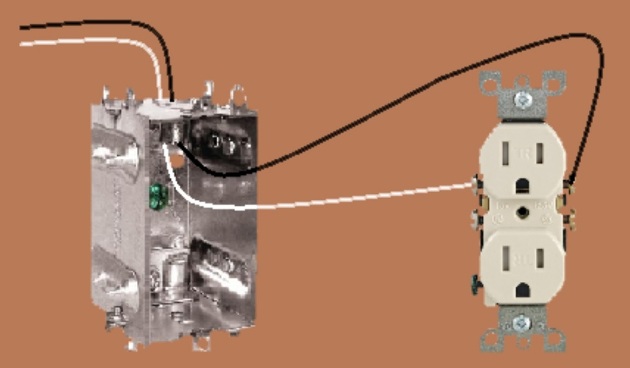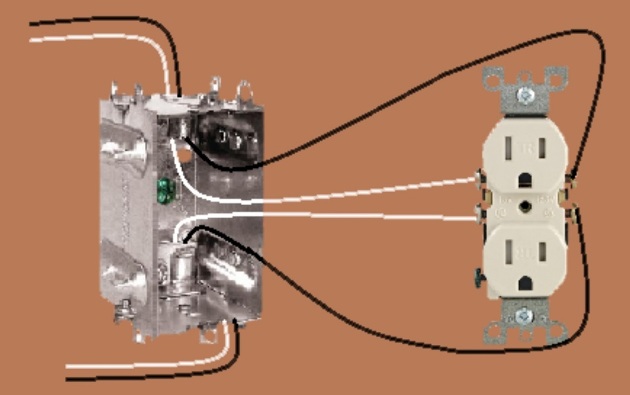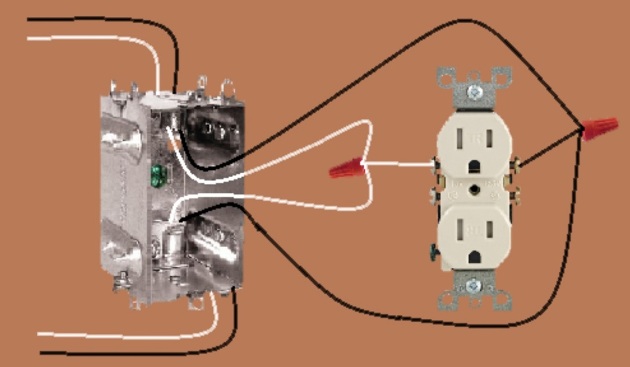
Adding an Outlet
How to install a new outlet
So you have a need to have a new outlet in a new location. What will be covered here is extending an existing circuit to a new outlet.
There are some things to consider…
a) Circuits that should not be extended…
A circuit that has any of these items on it (most of these items require dedicated circuits)….
Fridge, microwave, furnace, range, dryer, air conditioning, sump pumps, well pumps, hot water heaters, washer, dryer, split outlet kitchen circuits, and any other high current draw appliance / items. Circuits that already are drawing even periodically 70% of the rated max circuit load in my view should not be considered a candidate for extension.
b) Electrical codes at least in some jurisdictions may have a limit on the number of items / outlets per circuit, experts in the fields also recommend outlet / fixture limits on each circuit. That number seems to be from what I have seen to show up more often as from 10 to 12 items recommended max. for a general purpose circuit. Those items include lighting fixtures and outlets but switches are usually not counted (as switches do not consume power, they just turn off and on). My personal recommendation regardless of code is to never go over this limit for a general purpose circuit.
c) Consider the purpose of the new outlet installation, and what usage the candidate circuit that you are considering extending is currently serving. 14 gage wire is rated for 15 amp circuits, 12 gage wire is rated for 20 amp circuits (be sure that the fuse / breaker amp rating at the main panel is NOT greater than the rating for the wire cable attached to it) . In my jurisdiction I do not recall seeing a general purpose circuit with anything but 14 gage wiring (15 amp rated). Stab in (push in) back of outlet connections on outlets cannot be used with 12 gage wiring but only with 14 gage wires, although my preference is to always use the screw connectors rather than the stab in ones.
Things like vacuum cleaners, hair dryers, can be a big draw on amps. For example a 1500 watt hair dryer on a 110 – 120 volt circuit will draw around 13 amps, a vacuum cleaner can draw 11 – 12 amps. These are major power consumption drawers on a 15 amp max circuit, they are find by themselves, but if you have other things on the same circuit that accumulatively have a significant power draw, some of those items may cause the circuit to cross the line in amperage when a vacuum is added to it and when that happens the associated fuse or breaker at the main panel will shut down the circuit.
d) There has been cases where interference issues can exist between items used on the same circuit, particularly if there is any kind of mechanical items (such as a motor) on the same circuit.
So all the above items need to be considered when adding onto an existing circuit.
In some cases a new circuit wired directly to the main electrical panel may be the best option.
I have provided instructions on how to extend power from fixtures & switches in the switch wiring articles on this website, in this article I will explain extending the circuit from an existing outlet location.
EXTENDING TO A NEW OUTLET…
In order to extend a circuit, there must be present a grounded conductor (neutral), and a ungrounded conductor (hot), the electrical cable will also have an equipment grounding conductor. Unless the home is really old, for all modern wiring these wires will likely be (for outlet usage)…
white – for the grounded conductor (neutral)
black – for the ungrounded conductor
a bare wire for the equipment grounding conductor.
These are the common colors used for general purpose circuits in residential wiring cables (as it applies to United States & Canada). On split outlets and on 3 way and 4 way switch circuits there will also be an additional wire (usually red), in some situations a 4th wire may also be present in certain switch circuits that require the new NEC version 2011 404.2 rule compliance. By electrical codes certain color wires are designated to be used by a certain type of conductor, not following these rules will cause the work to fail an electrical inspection regardless if it technically works or not.
Most codes also require that the wire cable to be secured within 6 inches of the electrical box, meaning a wire clamp holding it to the wall stud.
IMPORTANT: remove the fuse / turn off the breaker of the circuit you are working on it.
Unless it is an very old home home, you will likely come across one of the following wiring configurations…
*a) end of the line / circuit outlet.

*b) incoming and onward circuit.

*c) incoming and onward circuit but using insulated wire nuts to connect wires.

Not shown in the diagram but all modern wiring will have one more wire, the bare wire is a equipment grounding wire, and that gets connected to the electrical box, and onward cables as well as to the grounding screw on the outlet.
Connections Instructions to an additional circuit section or outlet.
(as depicted in the diagrams above)
Now if the outlet you are extending power from is already at the end of the circuit run as depicted in the “a)” picture above then run another cable to the additional electrical box where you will be installing the new outlet. The onward cable will give you the configuration shown in “b)” or “c)” depending on rather you use the screws on the outlet to connect the next cable to or insulated wire nuts. The new outlet would be wired as depicted in “a)”
If the outlet you need to get power from is already configuration as in “b)” or “c)” at this point I would not recommend using the stab type connections in the back of outlet to attach the cable, but instead use an appropriate sized wire nut to connect all the wires together. You are never allowed to connect more than one wire under each connection screw of the switch. Insulated wire nuts comes in a variety of sizes, and it is important to get the correct size of wire nut for the type and number of wires you need to join.
Modern outlets have on one side will have 2 brass color screws and the other side will have 2 silver color screws. The black wire [which is the ungrounded conductor (hot)] connects to the brass color screws, when using insulated wire nuts then all the black wires get connected together (when dealing with outlet circuits). The white wire [which is the grounded conductor (neutral)] gets connected to the silver color screw of the outlet, when using insulated wire nuts then all white wires get connected together.
Now if you have a very old home, your wiring may not be of today’s standards, outlets may not even have an equipment grounding conductor. there may be two black wires instead of a white and black. Electrical codes and enforcement may not force you to update to modern standards (as long as it is not so bad that the wiring gets condemned); however new wiring additions to the home are required to meet current electrical code. If you are in this situation I would recommend that just run a brand new circuit and not try to extend power from an existing outlet.
Foreign Users:
The colors of the wires depicted are based on the standards and code requirements / configuration in the United States and Canada. If you are viewing this site from a foreign country, your wiring standards and color of wires may be different but the principal and sequence of wiring will still remain the same. Therefore the information in this article may still be of use to you regardless of what country you may be in. Just translate the colors used here to the color of wires used in your country in regards to ungrounded (hot) conductors / grounded conductors (neutral) and equipment grounding conductors as well know applicable code requirements in your country.
WHILE EXTREME CARE HAS BEEN IMPLEMENTED IN THE PREPARATION OF THIS SELF-HELP DOCUMENT, THE AUTHOR AND/OR PROVIDERS OF THIS DOCUMENT ASSUMES NO RESPONSIBILITY FOR ERRORS OR OMISSIONS, NOR IS ANY LIABILITY ASSUMED FROM THE USE OF THE INFORMATION, CONTAINED IN THIS DOCUMENT, BY THE AUTHOR and / OR PROVIDER.
By: Donald Kerr